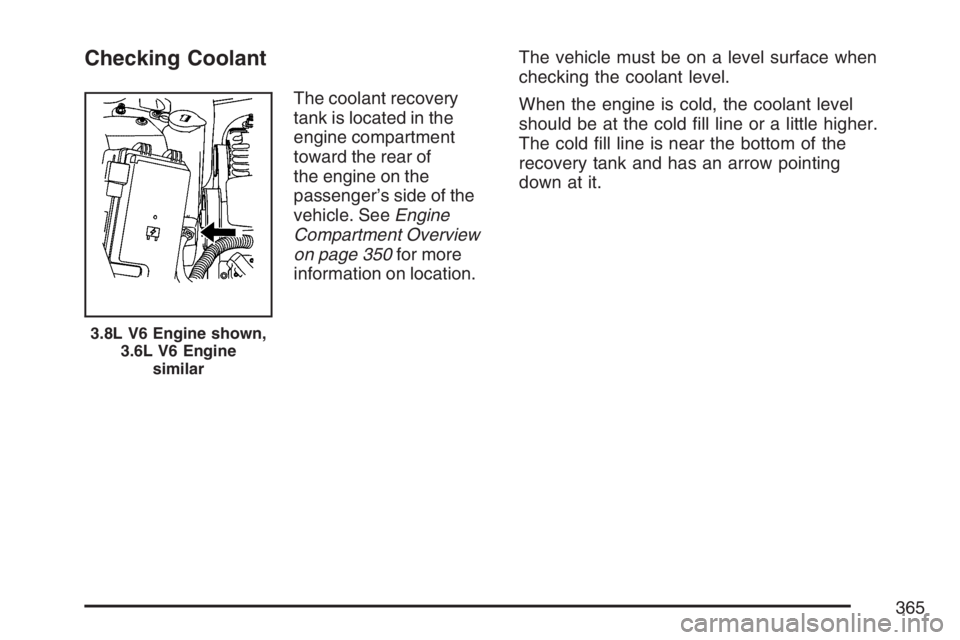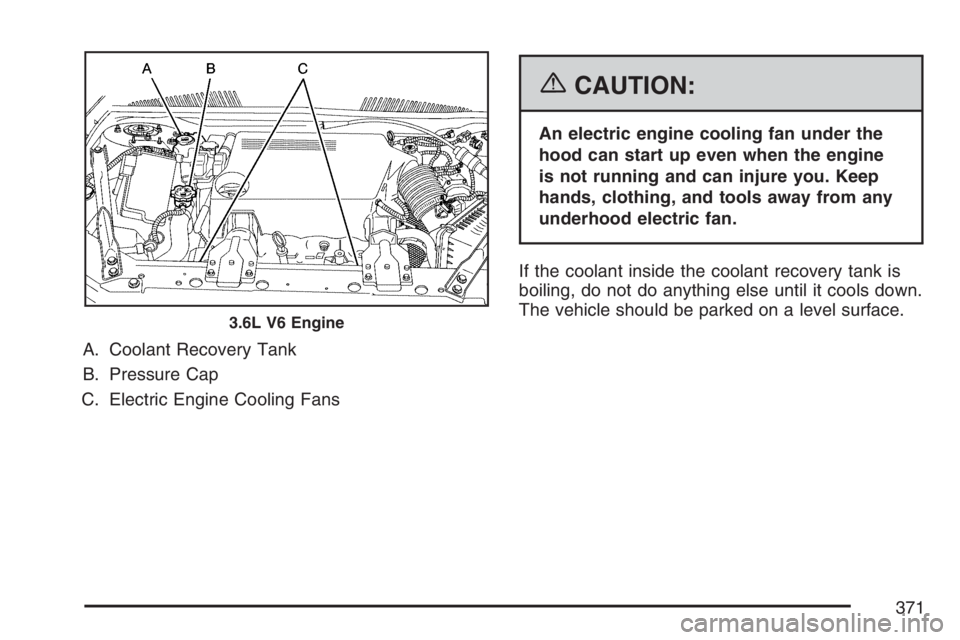2007 BUICK LACROSSE coolant level
[x] Cancel search: coolant levelPage 146 of 512

Anti-Lock Brake System Warning Light...... 187
Traction Control System (TCS)
Warning Light........................................ 187
Engine Coolant Temperature
Warning Light........................................ 188
Engine Coolant Temperature Gage............ 189
Low Coolant Warning Light....................... 189
Tire Pressure Light.................................... 190
Malfunction Indicator Lamp........................ 190
Oil Pressure Light..................................... 194
Change Engine Oil Light........................... 195
Security Light............................................ 195
Cruise Control Light.................................. 195
Reduced Engine Power Light.................... 196
Highbeam On Light................................... 196
Headlamps Suggested Light...................... 196
Low Washer Fluid Warning Light............... 197
Door Ajar Light.......................................... 197
Trunk Ajar Light........................................ 197
Service Vehicle Soon Light........................ 197
Fuel Gage................................................. 198
Low Fuel Warning Light............................ 198
Check Gas Cap Light................................ 199Driver Information Center (DIC)................... 199
DIC Operation and Displays...................... 200
DIC Compass (Uplevel Only)..................... 206
DIC Warnings and Messages.................... 208
DIC Vehicle Personalization....................... 229
Audio System(s)......................................... 238
Setting the Time........................................ 239
Radio with CD (Base)............................... 240
Radio with CD (Uplevel)............................ 245
Radio with CD (MP3)................................ 252
Radio with Six-Disc CD............................. 260
Using an MP3........................................... 272
XM Radio Messages................................. 278
Theft-Deterrent Feature............................. 280
Audio Steering Wheel Controls.................. 280
Radio Reception........................................ 281
Care of Your CDs..................................... 282
Care of the CD Player.............................. 282
Backglass Antenna.................................... 283
XM™ Satellite Radio Antenna System....... 284
Chime Level Adjustment............................ 284
Section 3 Instrument Panel
146
Page 208 of 512

DIC Warnings and Messages
Messages are displayed on the uplevel DIC to
notify the driver that the status of the vehicle has
changed and that some action may be needed
by the driver to correct the condition. Multiple
messages may appear one after another.
Some messages may not require immediate
action, but you can press any of the DIC buttons
on the uplevel vehicle to acknowledge that
you received the message and clear it from the
DIC display.
Some messages cannot be cleared from the DIC
display because they are more urgent. These
messages require action before they can be
cleared.
If there are any active warning messages when
the vehicle is turned off, two chimes sound and the
DIC goes into a reminder mode. The reminder
mode displays any active message. If there
are multiple messages, the DIC displays each
message for �ve seconds. After each active
message is displayed once, the reminder mode
turns off.You should take any messages that appear on the
display seriously and remember that clearing
the messages will only make the messages
disappear, not correct the problem.
The following are the possible messages that can
be displayed and some information about them.
A/C OFF FOR ENGINE PROTECTION
This message displays when the engine coolant
becomes hotter than the normal operating
temperature. SeeEngine Coolant Temperature
Gage on page 189. To avoid added strain on a hot
engine, the air conditioning compressor is
automatically turned off. When the coolant
temperature returns to normal, the air conditioning
compressor turns back on. You can continue to
drive your vehicle.
This message comes on while the ignition is in
RUN. Press any of the DIC buttons to acknowledge
this warning message and to clear it from the
screen.
208
Page 351 of 512

A. Windshield Washer Fluid Reservoir. See
“Adding Washer Fluid” underWindshield
Washer Fluid on page 380.
B. Battery. SeeBattery on page 384.
C. Remote Positive (+) Terminal. SeeJump
Starting on page 385.
D. Underhood Fuse Block. SeeUnderhood Fuse
Block on page 452.
E. Passenger Compartment Air Filter. See
Passenger Compartment Air Filter on page 178.
F. Engine Coolant Recovery Tank. SeeCooling
System on page 370.
G. Power Steering Fluid Reservoir. SeePower
Steering Fluid on page 378.
H. Pressure Cap. SeeRadiator Pressure Cap
on page 367.I. Engine Oil Fill Cap. See “When to Add Engine
Oil” underEngine Oil on page 353.
J. Electric Engine Cooling Fans. SeeCooling
System on page 370.
K. Engine Oil Dipstick. See “Checking Engine Oil”
underEngine Oil on page 353.
L. Automatic Transaxle Fluid Dipstick. See
“Checking the Fluid Level” underAutomatic
Transaxle Fluid on page 360.
M. Brake Master Cylinder Reservoir. See “Brake
Fluid” underBrakes on page 381.
N. Engine Air Cleaner/Filter. SeeEngine
Air Cleaner/Filter on page 358.
351
Page 353 of 512

A. Windshield Washer Fluid Reservoir. See
“Adding Washer Fluid” underWindshield
Washer Fluid on page 380.
B. Battery. SeeBattery on page 384.
C. Remote Positive (+) Terminal. SeeJump
Starting on page 385.
D. Passenger Compartment Air Filter. See
Passenger Compartment Air Filter on page 178.
E. Underhood Fuse Block. SeeUnderhood
Fuse Block on page 452.
F. Engine Coolant Recovery Tank. SeeCooling
System on page 370.
G. Radiator Pressure Cap. SeeRadiator Pressure
Cap on page 367.
H. Power Steering Fluid Reservoir (Out of View).
SeePower Steering Fluid on page 378.
I. Electric Engine Cooling Fans. SeeCooling
System on page 370.
J. Engine Oil Dipstick. See “Checking Engine Oil”
underEngine Oil on page 353.
K. Engine Oil Fill Cap. See “When to Add Engine
Oil” underEngine Oil on page 353.
L. Automatic Transaxle Fluid Dipstick. See
“Checking the Fluid Level” underAutomatic
Transaxle Fluid on page 360.M. Engine Coolant Bleed Valve. See “How to Add
Coolant to the Radiator” underCooling
System on page 370.
N. Brake Master Cylinder Reservoir. See “Brake
Fluid” underBrakes on page 381.
O. Engine Air Cleaner/Filter. SeeEngine Air
Cleaner/Filter on page 358.
Engine Oil
Checking Engine Oil
It is a good idea to check the engine oil every time
you get fuel. In order to get an accurate reading,
the oil must be warm and the vehicle must be
on level ground.
The engine oil dipstick handle is a yellow loop.
SeeEngine Compartment Overview on page 350
for the location of the engine oil dipstick.
1. Turn off the engine and give the oil several
minutes to drain back into the oil pan. If you
do not do this, the oil dipstick might not
show the actual level.
2. Pull out the dipstick and clean it with a paper
towel or cloth, then push it back in all the
way. Remove it again, keeping the tip down,
and check the level.
353
Page 365 of 512

Checking Coolant
The coolant recovery
tank is located in the
engine compartment
toward the rear of
the engine on the
passenger’s side of the
vehicle. SeeEngine
Compartment Overview
on page 350for more
information on location.The vehicle must be on a level surface when
checking the coolant level.
When the engine is cold, the coolant level
should be at the cold �ll line or a little higher.
The cold �ll line is near the bottom of the
recovery tank and has an arrow pointing
down at it.
3.8L V6 Engine shown,
3.6L V6 Engine
similar
365
Page 366 of 512

Adding Coolant
If more coolant is needed, add the proper
DEX-COOL®coolant mixture at the coolant
recovery tank, but be careful not to spill it.
If the coolant recovery tank is completely empty,
add coolant to the radiator. SeeEngine
Overheating on page 367.
{CAUTION:
Turning the radiator pressure cap when
the engine and radiator are hot can allow
steam and scalding liquids to blow out
and burn you badly. With the coolant
recovery tank, you will almost never
have to add coolant at the radiator. Never
turn the radiator pressure cap — even
a little — when the engine and radiator
are hot.
{CAUTION:
You can be burned if you spill coolant
on hot engine parts. Coolant contains
ethylene glycol, and it will burn if the
engine parts are hot enough. Do not spill
coolant on a hot engine.
Occasionally check the coolant level in the
radiator. For information on how to add coolant to
the radiator, seeCooling System on page 370.
366
Page 371 of 512

A. Coolant Recovery Tank
B. Pressure Cap
C. Electric Engine Cooling Fans
{CAUTION:
An electric engine cooling fan under the
hood can start up even when the engine
is not running and can injure you. Keep
hands, clothing, and tools away from any
underhood electric fan.
If the coolant inside the coolant recovery tank is
boiling, do not do anything else until it cools down.
The vehicle should be parked on a level surface.
3.6L V6 Engine
371
Page 372 of 512

When the engine is cold, the coolant level should
be at or above the cold �ll line on the coolant
recovery tank. If it is not, there may be a leak at the
pressure cap or in the radiator hoses, heater hoses,
radiator, water pump, or somewhere else in the
cooling system.
{CAUTION:
Heater and radiator hoses, and other
engine parts, can be very hot. Do not
touch them. If you do, you can be burned.
Do not run the engine if there is a leak.
If you run the engine, it could lose all
coolant. That could cause an engine �re,
and you could be burned. Get any leak
�xed before you drive the vehicle.If there seems to be no leak, with the engine on,
check to see if the electric engine cooling fans
are running. If the engine is overheating, the fans
should be running. If the fans are not running,
the vehicle needs service.
Notice:Engine damage from running your
engine without coolant is not covered by your
warranty. SeeOverheated Engine Protection
Operating Mode on page 370for information
on driving to a safe place in an emergency.
Notice:Using coolant other than DEX-COOL®
may cause premature engine, heater core,
or radiator corrosion. In addition, the engine
coolant could require changing sooner, at
30,000 miles (50 000 km) or 24 months,
whichever occurs �rst. Any repairs would not
be covered by your warranty. Always use
DEX-COOL
®(silicate-free) coolant in your
vehicle.
372